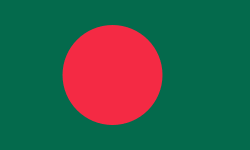Gopalganj District (Gopalganj)
Gopalganj is subdivided into five sub-districts (upazila/thana).
The Office of the Deputy Commissioner, Gopalganj has developed a web portal of the district as www.gopalganj.gov.bd under the 'Access to Information' program of the Prime Minister's Office. This has been done under the Digital Bangladesh implementation concept of the incumbent government.
In 1800, Preetiram Das of Janbazar, Kolkata purchased Makimpur Porgona (in present days under the area of Gopalganj) costing 19 thousand taka and became the landlord of the Porgona. Babu Rajachandra Das, the 2nd son of Preetiram Das was married to Rani Rasmoni of Mahishya clan in 4th April, 1804. Landlord Rajachandra died only at 49 leaving his widowed wife Rani Rasmoni and 3 dauthers in 9th June, 1836. Padmamoni, the eldest daughter of Rani Rasmoni, got married to Ramchandra and gave birth to 7 children; Mahendranath, Ganeshchandra, and five others. Mahendranath, eldest son of Padmamoni and Ramchandra died at a premature age and Ganeshchandra (2nd son) became landlord of the estate. To show respect to Rani Rasmoni, the tenants of Khatra estate changed the name of Rajganj Bajar to Gopalganj (Gopal from Nabo Gopal and Ganj from Ranjganj) following the name of Nabo Gopal, son of Ganeshchandra and great grandson of Rani Rasmoni.
This area was under the southern part of ancient Bengal called Vanga. Around 300 BC here in Kotalipara was the capital of Gangaridai dynasty. Gangaridai was one of the powerful kingdom of Indian subcontinent. It was described by the Greek traveller Megasthenes in his work Indica. During Sultanate and Mughal period several Hindu kings ruled the area. In 1713, Muksudpur Upazila was part of Jessore district while the rest of Gopalganj was part of Dhaka - Jalalpur District. Muksedpur was later transferred to Faridpur district in 1807. Gopalgaj Gopalganj Sadar and Kotalipara was part of Jalalpur Porgona of Faridpur district. Chandana (now Modhumoti) river was the borderline for Jessore and Dhaka - Jalalpur districts in 1812. Gopalgnaj - Madaripur was a large water body back then where maritime robbery was a regular activity. Thus, Madaripur Mohakuma or Sub-division was separated in 1854 from Bakergonj District.
Later, Gopalganj emerged as a police station in 1872 under the Madaripur Mohakuma or Sub-division vide Calcutta Gazette of 1870. In 1873, Madaripur Mohakuma or Sub-division was transferred to Faridpur district from Bakergonj district. Later in 1909, it was separated from the Madaripur Mohakuma of Bakergonj district to form a new Gopalganj Mohhakuma or sub-division. Later, Muksudpur Police Station of Faridpur district joined Gopalganj and Kotalipara police stations of Gopalganj Mohakuma or sub-division of Faridpur district.
The first SDO (sub-divisional officer) was Mr. Suresh Chandra Sen. In 1910, the sub-divisional officer's bench court was transformed into Criminal Court. In 1921, Gopalganj was elevated to township status which was inhabited by only 3,478 persons. 1925 saw the initiation of Civil Court. In 1936, Muksudpur was split to form Kashiani police station.
Gopalganj Mohakuma or sub-division emerged as Gopalganj district on the 1st day of February in 1984. Mr. AFM Ehiya Chowdhury was the first District Commissioner of Gopalganj District.
In the same year, Tungipara was separated from the Sadar Upazila to form a new upazila namely Tungipara upazila. After the liberation war in 1972, Gopalganj Sadar became Municipality or Pourashava and Panna Biswas was selected as its first chairman.
Map - Gopalganj District (Gopalganj)
Map
Country - Bangladesh
 |
 |
| Flag of Bangladesh | |
The official language is Bengali, one of the easternmost branches of the Indo-European language family.
Currency / Language
| ISO | Currency | Symbol | Significant figures |
|---|---|---|---|
| BDT | Bangladeshi taka | ৳ | 2 |
| ISO | Language |
|---|---|
| BN | Bengali language |
| EN | English language |















